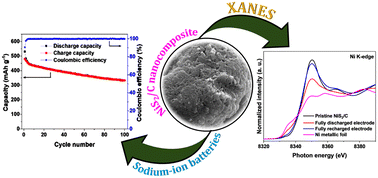A NiS2/C composite as an innovative anode material for sodium-ion batteries: ex situ XANES and EXAFS studies to investigate the sodium storage mechanism
Abstract
The successful deployment of sodium-ion batteries (SIBs) requires high-performance sustainable and cost-effective anode materials having a high current density. In this regard, sodium disulphide (NiS2) has been prepared as a composite with activated carbon (C) using a facile hydrothermal synthesis route in the past. The X-ray diffraction pattern of the as-prepared NiS2/C composite material shows well-defined diffraction peaks of NiS2. Most carbonaceous materials are amorphous, and the Brunauer–Emmett–Teller (BET) study shows that the surface area is close to 148 m2 g−1. At a current density of 50 mA g−1, the NiS2/C composite exhibits a high capacity of 480 mA h g−1 during the initial cycle, which subsequently decreases to 333 mA h g−1 after the completion of the 100th cycle. The NiS2/C composite electrode provides an exceptional rate capability by delivering a capacity of 270 mA h g−1 at a high current density of 2000 mA g−1, suggesting the suitability of the NiS2/C composite for SIBs. Ex situ X-ray absorption near edge structure (XANES) and extended X-ray absorption fine structure (EXAFS) analyses at the Ni K-edge have been used to examine the type of chemical bonding present in the anode and also how it changes during electrochemical redox cycling. The understanding of the sodium storage mechanism is improved by the favorable results, which also offer insights for developing high-performance electrode materials for rechargeable SIBs.



 Please wait while we load your content...
Please wait while we load your content...